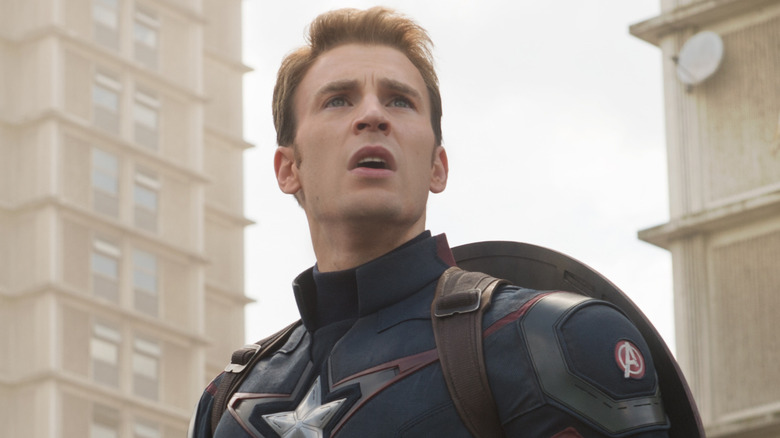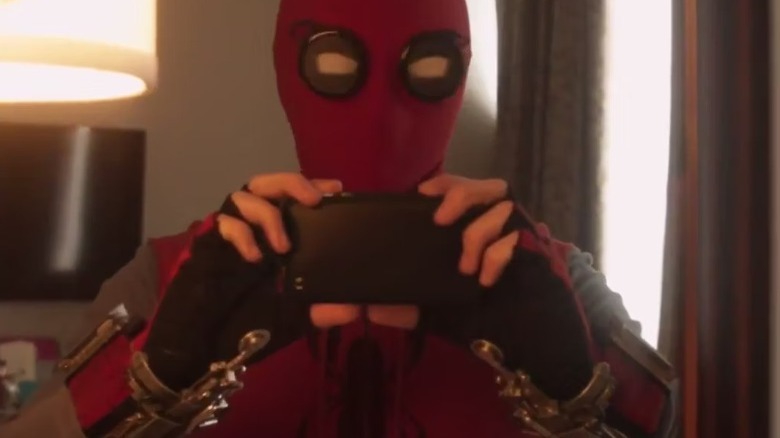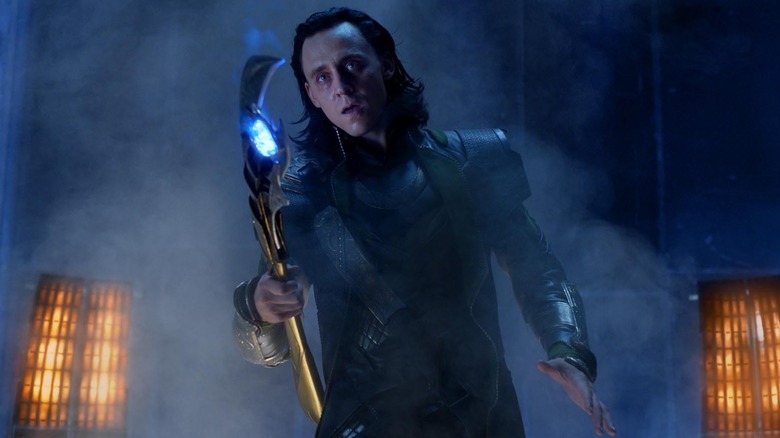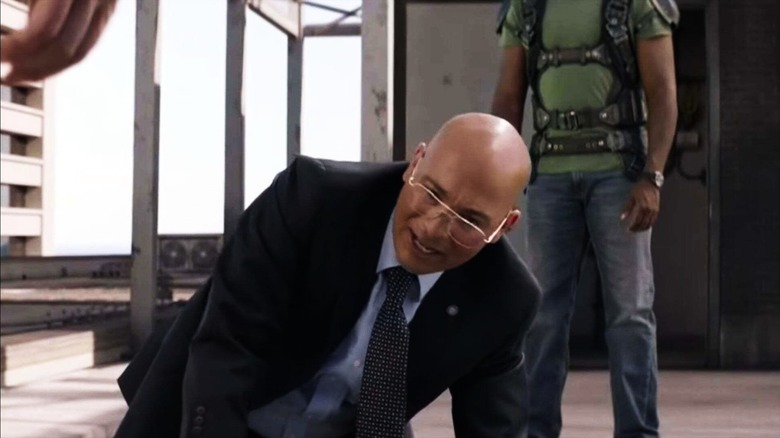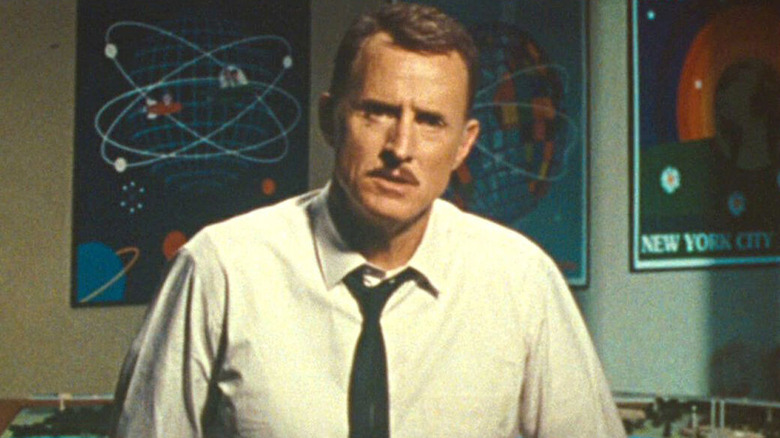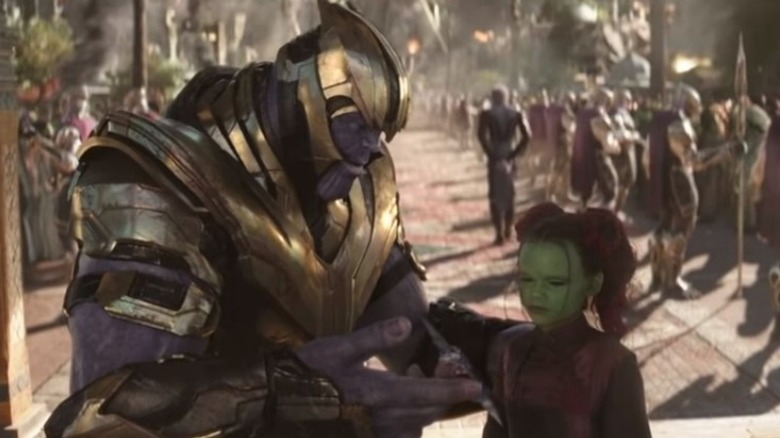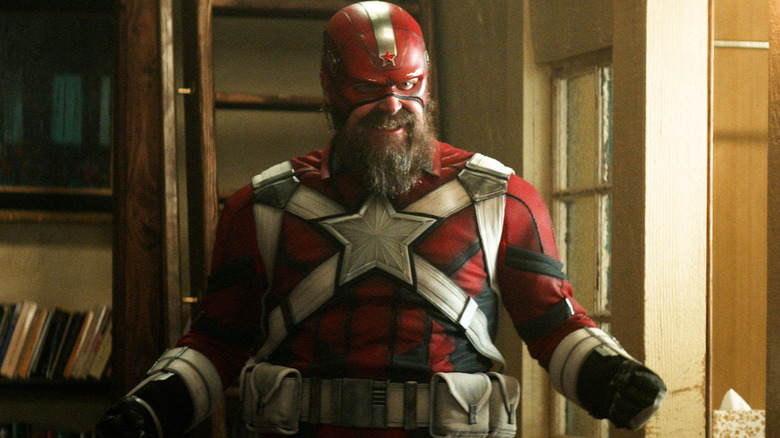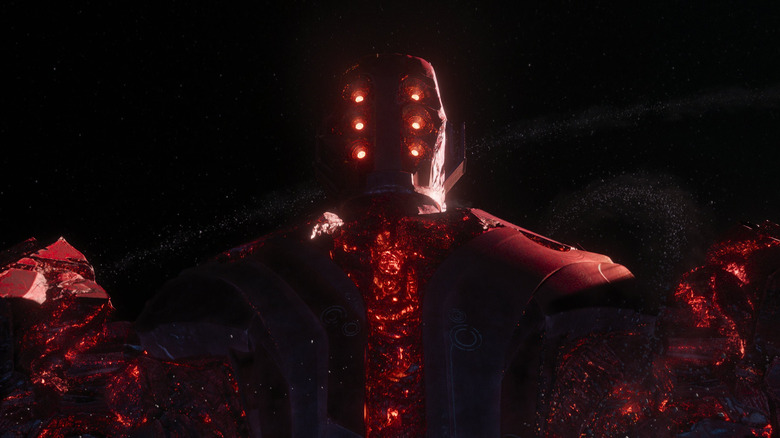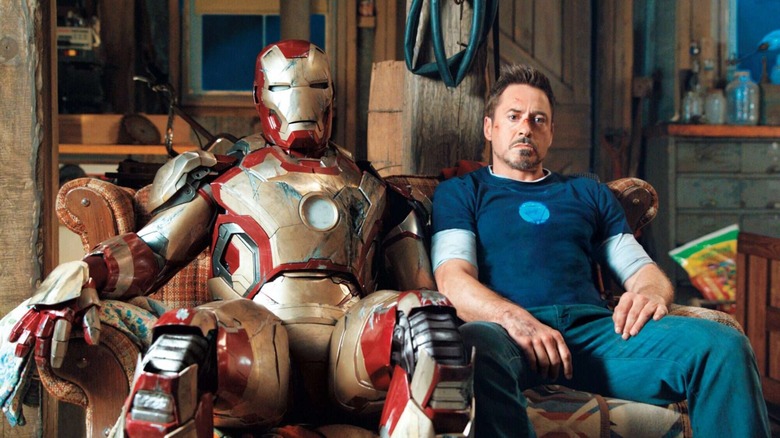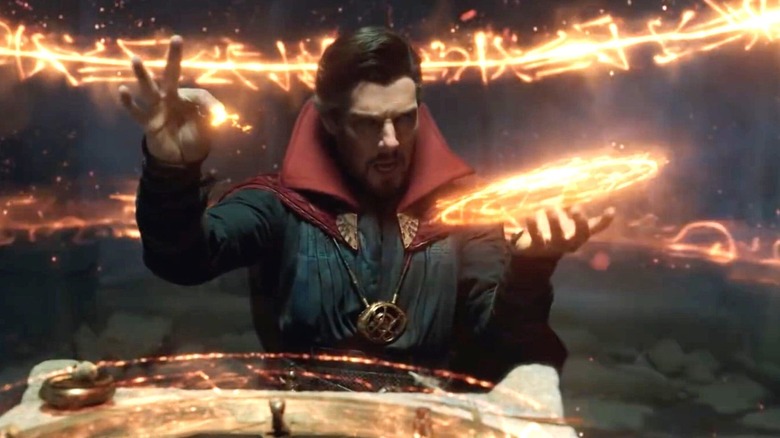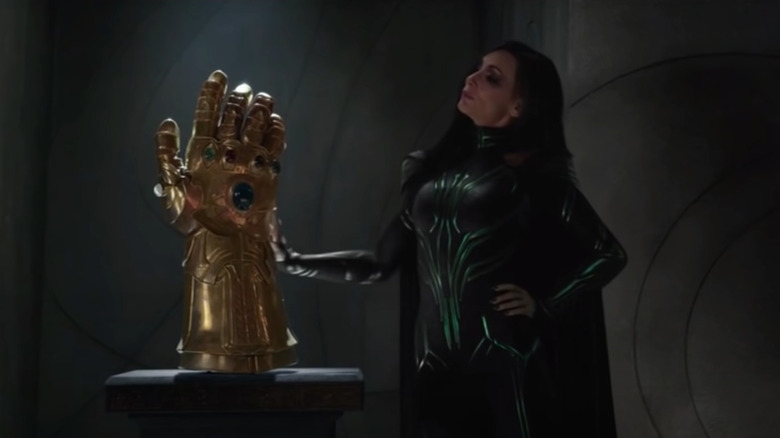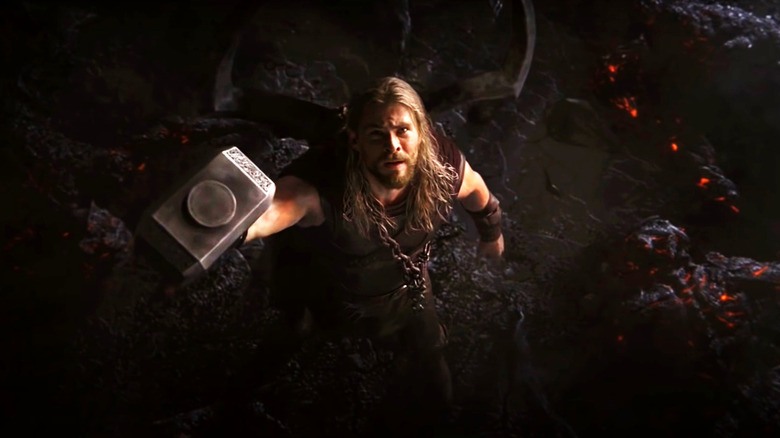The Most Frustrating Plot Holes In The MCU
Marvel Studios has created a film and television franchise unlike any other. Intricately stitching together stories that reference and introduce one another, each Marvel Cinematic Universe character and project feels like it's a fully realized world. Despite containing over twenty films and numerous television shows, Kevin Feige, talented producers, and filmmakers have worked together for over a decade to forge a complex yet coherent series that fans and critics adore. Marvel Studios' penchant for planning projects in advance has led to plot seeds growing into overarching and fruitful storylines.
Despite Marvel Studios' attention to the MCU's continuity, there have been a few lapses in logic sneaking into its ongoing saga. It's best not to be too picky about the occasional lapse in narrative logic: after all, this is a universe that involves aliens, alternate dimensions, and superpowers. Pointing out things that don't make sense is about as productive as pointing out that the oceans have some water. Considering how outré the movies are, overall, Marvel Studios has done a terrific job of weaving together multiple characters and stories into a fairly cohesive whole.
Still, several inconsistencies in the ever-expanding Marvel Cinematic Universe have arisen over the years, some of which create some glaring story problems. Let's look at some of the MCU's most frustrating plot holes.
Spider-Man's vlog contradicts the events of Captain America: Civil War
Near the beginning of "Spider-Man: Homecoming," there's footage Peter Parker shot of himself before, during, and after the big superhero brawl at the Leipzig-Halle Airport. The audience sees his point of view when he's first introduced as Spider-Man to Captain America and his team just before the massive showdown. Peter continues recording himself with some teenage color commentary throughout the melee. When Ant-Man grows to the size of a building, the excited Peter turns around and says, "What the hell? He's big now! I gotta go! Hang on!"
However, that's not how the scene played out in "Captain America: Civil War." In that film, when Ant-Man reluctantly uses his suit to become a giant, Spider-Man is clearly shocked at the new development and exclaims, "Holy s***!" There's no sign of him recording himself or the fight.
This inconsistency doesn't present major narrative distractions in the MCU. Still, it's a little confusing. But it's clear that the filmmakers behind "Spiderman: Homecoming" closely watched "Civil War" to depict the clash of heroes from an eager Peter's perspective. Comparatively, the scenes from each film match up pretty well. However, let's give Peter Parker some credit for toning down the profanity for his first solo outing.
Why did Thanos give the Mind Stone to Loki?
The first scene of "The Avengers" depicts Thanos' right-hand man, The Other, narrating their plan to take over the Earth and retrieve the Tesseract. Loki leads the charge with his scepter, which has powers like energy projection and mind control. However, Loki's efforts to invade the planet with the Chitauri army fail thanks to the Avengers. Loki and the Tesseract go into Asgardian custody, and Loki's scepter falls into Hydra's possession. Later, "Avengers: Age of Ultron" revealed that Loki's scepter houses the Mind Stone, one of the six fabled Infinity Stones. In "Avengers: Infinity War," the Tesseract is a housing for the Space Stone.
But in Thanos' years-long quest to acquire all Infinity Stones, it's unclear why he gave one of them to Loki. As a mighty space tyrant, Thanos surely would have access to other powerful weapons to loan to the God of Mischief fueled by something of which there are only six in the universe. Thanos sent Loki to Earth to retrieve the Tesseract. But Loki's failure resulted in Thanos not only missing his chance to obtain the Infinity Stone, but also losing a Mind Stone. After Ronan failed him in "Guardians of the Galaxy," Thanos ultimately learned his lesson: when conquering the universe, don't outsource to freelancers.
Why was Doctor Strange considered a threat to Hydra?
"Captain America: The Winter Solider" shows Steve Rogers and Natasha Romanoff recruiting Sam Wilson in their quest to expose Hydra. The trio head to Washington D.C. to confront S.H.I.E.L.D. agent and Hydra mole Jasper Sitwell. While reluctant to talk at first, Sam threatens to drop Jasper from a great height with the help of his wingsuit. Jasper then reveals that Arnim Zola, who survived for decades by uploading his consciousness into a series of computer memory banks, created an algorithm that could determine if a person would have the potential to get in Hydra's way. Hydra utilized the helicarriers S.H.I.E.L.D. created for Project Insight to eliminate these individuals. Jasper then listed people Hydra regarded as threats, including Tony Stark, Bruce Banner, and Stephen Strange.
This MCU moment delighted fans as the Master of the Mystic Arts' MCU debut was still several years away. However, at the beginning of "Doctor Strange," Stephen Strange is still a prominent surgeon. He hadn't undertaken combat training, mystical adventures, or pledged himself to protect the Earth from otherworldly dangers. Compared to heavy hitters like Stark and Banner, he doesn't seem like someone Hydra would be worried about or put on a hit list.
Howard Stark's overly complicated yet oddly convenient plan for Tony Stark
"Iron Man 2" saw Tony Stark deal with the problems caused by his arc reactor. While Tony's arc reactor keeps metal shrapnel from entering his heart and killing him, it's giving him palladium poisoning. Nick Fury and Natasha Romanoff meet with Tony and provide him with his father's research. They believe Howard Stark was onto something big, but he didn't have the technology to finalize it. His research may be the key to saving Tony's life. Tony puts together a scale model of the 1974 Stark Expo, which he deduces is the layout for an element that doesn't yet exist. After this realization, Tony rewires his home to power a particle accelerator to create a new element. He then uses its power in his latest arc reactor, freeing him from palladium poisoning.
Geez, there are so many questions to ask about this plot point! It makes sense that Howard was researching something the technology of the time couldn't develop, so he passed it on to his son to complete. But why did he hide clues in a diorama of the 1974 Stark Expo? Why did S.H.I.E.L.D. wait so long to give this information to Tony? How did they know that it would solve Tony's palladium poisoning?
Gamora's inconsistent backstory
In "Guardians of the Galaxy," Gamora is apprehended by the Nova Corps along with Rocket Raccoon, Groot, and Star-Lord. During their lineup, each has their background information displayed. Gamora's information states that she is the last surviving member of the Zehoberei people. Corpsman Rhomann Dey then reveals that she is the adopted daughter of Thanos. Her lineage is elaborated further in "Avengers: Infinity War," which features a flashback of Thanos wiping out the Zehoberei people, with the exception of a young Gamora. He decides to adopt her because of her courage to fight him. After Thanos kidnaps Gamora from Knowhere, he shares his plan with her. By having half of their population annihilated, there were enough resources for the surviving half to live fruitful lives.
This minor discrepancy is one of the handfuls of times that a detail presented in an MCU movie is forgotten about in another MCU project years later. Still, Gamora being the last surviving member of her species gave her a bit of pathos, making her more complex than just an assassin for an intergalactic titan. This plot hole raises some additional questions. Why did the Nova Corp believe that Gamora was the last survivor of the Zehoberei people? If Gamora knew half of her people's population was still alive, why didn't she return to her planet?
Why does Red Guardian claim he fought Captain America?
Alexei Alanovich Shostakov, aka Red Guardian, was Russia's answer to America's Captain America. They gave Alexei a version of the Super Soldier serum, and he went on many missions for the Soviet Armed Forces before being imprisoned by General Dreykov. Wallowing in regret and self-pity in prison, Alexei regaled his fellow inmates with stories of his 1980s bout with Captain America. He bragged about beating America's premier super soldier. However, Ursa Major pointed out to Alexei that his fight with Captain America couldn't have happened. During that time, Cap was frozen in the ocean. Of course, Alexei doesn't take this well and breaks Ursa's arm.
With the risk of incurring Alexei's wrath, it's a fair point. In MCU continuity, Steve Rogers is revived sometime before "The Avengers," which takes place in 2012. Alexei is likely lying about his fight with Captain America, but there's a chance the story is partially true. "The Falcon and the Winter Soldier" revealed Isaiah Bradley was a part of America's Super Soldier program. He went on several missions before being imprisoned and experimented on, suggesting that Isaiah could have previously fought Red Guardian. Or perhaps Red Guardian fought Steve Rogers when he went back in time to restore the Infinity Stones?
The inconsistent story of the Celestials
In MCU's lore, the Celestials are incredibly ancient and powerful beings responsible for creating the spark that spawned existence. They were introduced in "Guardians of the Galaxy" when Star-Lord, Gamora, Rocket Raccoon, and Groot deliver the Orb to the Collector on Knowhere (which is the head of a long-dead Celestial). The Collector explains that the Orb contains the Power Stone, one of the six Infinity Stones, and gives its owner immeasurable power. He shows the Guardians a display of one of the Celestials using it to destroy an entire planet.
The next mention of Celestials came in "Guardians of the Galaxy Vol. 2," which introduced Star-Lord's father Ego as a member of the age-old race. The film calls Ego the last existing Celestial. But then "Eternals" established that Arishem the Judge is alive, and even has another Celestial Tiamut, napping inside the Earth. What's the deal, Marvel Studios?
This discrepancy is most likely due to Marvel Studios giving two talented directors — James Gunn and Chloé Zhao — creative freedom to use the Celestials as they saw fit. Unfortunately, this results in conflicting backstories for the ancient race. So far, the Celestials are mostly background characters in the Marvel Cinematic Universe, which gives the studio future leeway to fully explain their origin later.
Tony Stark destroyed his Iron Man armors, only to replace them right after
"Iron Man 3" took place shortly after the events of "The Avengers." Most of this MCU film dealt with Tony Stark's panic attacks and insomnia following his experience with the Chitauri attack on New York City. He contends with these feelings by constantly building newer suits. However, this creates tension with his girlfriend, Pepper Potts, who's grown increasingly worried about his obsession. After defeating Aldrich Killian and his group of Extremis-enhanced soldiers, Iron-Man's identity crisis seems resolved. He destroys his remaining Iron Man suits to prove his dedication to Pepper. However, Tony slips right back into his old ways in "Captain America: Civil War," where he reveals he's back to building Iron Man suits, and his relationship with Pepper is on hold — likely due to his return to form.
There's no doubt that Tony Stark was born to build. Likely, Marvel Studios thought it was too early for him to hang up his suits. But since he returned to his obsession, wouldn't it be safe to assume that his PTSD from the events of "The Avengers" also returned? Sure, he got to air his feelings to a sleeping Bruce Banner (as seen in the post-credits scene of "Iron Man 3"), so that probably helped. However, the film dismissed his struggle with a couple of throwaway lines like: "It was no big deal."
If you or someone you know needs help with mental health, please contact the Crisis Text Line by texting HOME to 741741, call the National Alliance on Mental Illness helpline at 1-800-950-NAMI (6264), or visit the National Institute of Mental Health website.
Doctor Strange's spell in Spider-Man: No Way Home
When the world learns that Spider-Man is Peter Parker, he feels responsible for how his exposed identity ruins the lives of those he cares most about. To remedy the situation, Peter turns to Doctor Strange, who proposes that he cast a spell to make everyone forget who Spider-Man is. However, as Strange is performing the ritual, the eager Peter keeps interrupting to request that individuals — like Aunt May, Ned Leeds, and MJ — be allowed to know his secret, ruining the spell. Later, Peter learns through a confrontation with Doctor Octopus and Green Goblin from Sam Raimi's Tobey Maguire-starring "Spider-Man" movies that his interjections resulted in pulling individuals from other universes who knew Spider-Man's secret identity into his universe.
It can sound extra nerdy to poke holes in the logic of a magical spell, but this spell raises some logistical questions. While Strange claimed this magic only worked on people's memories, would that be enough to solve Peter's problem? Considering J. Jonah Jameson already released his Spidey evidence to the world, all someone would have to do is rewatch the footage, and they'd instantly know that Peter was Spider-Man. Also, Strange stated that his spell brought those who knew about Spider-Man's secret identity into the Tom Holland-starring Spider-Man universe and those who were fated to die in their respective timelines. However, the Lizard and the Sandman survived in their universes. Get the story straight, Strange!
Why does Odin have a fake Infinity Gauntlet?
In the first three phases of the Marvel Cinematic Universe, the Infinity Gauntlet's purpose and its role were explained and teased over numerous films before eventually becoming the main plotline of "Avengers: Infinity War" and "Avengers: Endgame."
There's an early Infinity Gauntlet tease in 2011's "Thor." When Thor is about to be crowned prince of Asgard, several Frost Giants break into Odin's trophy room to steal the Casket of Ancient Winters. In the background, there's a shot of an Infinity Gauntlet — and it's fully loaded, too. However, look a little closer, and it's easy to see its design is for a right hand. The Infinity Gauntlet Thanos uses in "Avengers: Infinity War" is for his left hand. Years later, "Thor: Ragnarok" confirmed Thor's gauntlet was a fake creation made by Hela, who casually knocks it over in the film, declaring that most of Odin's trophies are fake.
So what is Odin doing with not only a fake Infinity Gauntlet, but also fake Infinity Stones? Was Odin lying to everyone about owning something as universally (in the literal sense) sought? The most likely scenario is that Marvel Studios had already planned out the Infinity Saga in 2011, and their team snuck the right-handed gauntlet into Odin's trophy room as a fun little nod to the comics. Later, the creative teams added that scene with Hela to cover their tracks. Nice try, Marvel.
How Thor only sometimes needs Heimdall to travel across the universe
In "Thor," it's established that the primary means for Asgardians to travel across the universe is through the Bifrost, which Heimdall controls. However, in Thor's climactic battle with Loki, he destroys the Rainbow Bridge. The Bifrost falls into space, preventing any Asgardians from leaving. Thor appears again in "The Avengers," wherein Loki surmises that Odin had to summon Dark Energy to send Thor to Earth. By the time "Thor: The Dark World" takes place, a new Bifrost has been built.
However, there are some inconsistencies in how Thor gets around the cosmos. At the end of "Avengers: Age of Ultron," Thor aims Mjolnir at the sky and teleports to Asgard. But in "Thor: Ragnarok," Thor is trapped in Muspelheim fighting off Surtur's legions as Heimdall's substitute, Skurge, is too busy entertaining women to notice Thor's call.
It makes more sense for Thor being able to travel across the universe after getting Stormbreaker. Based on how comic book magic works, Stormbreaker likely comes with all kinds of wacky powers that don't require exposition. However, the MCU firmly established Thor could only travel between Earth and Asgard through the Bifrost. Is there a stash of Dark Energy he can use during peak Bifrost hours?
